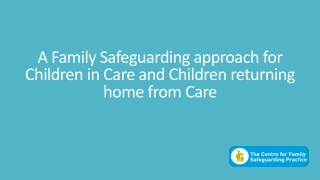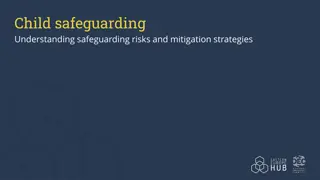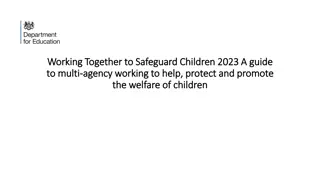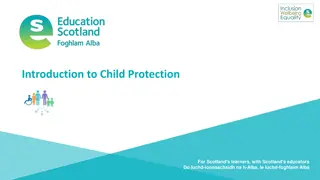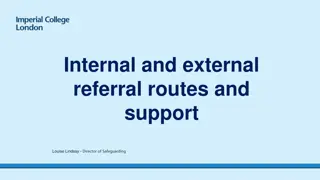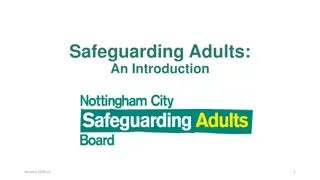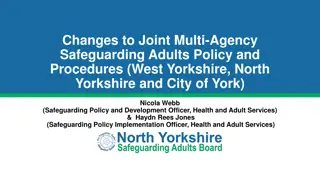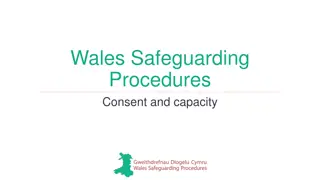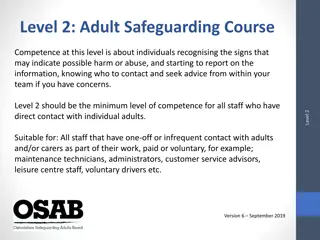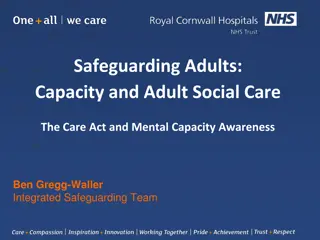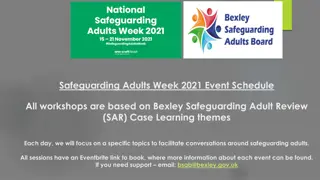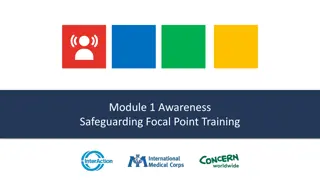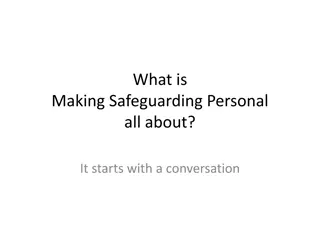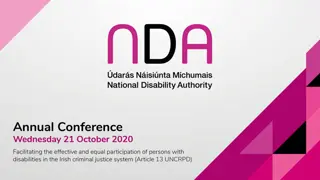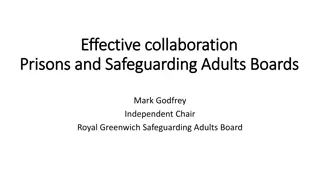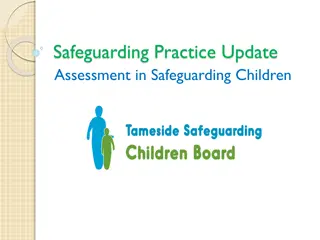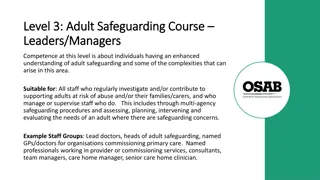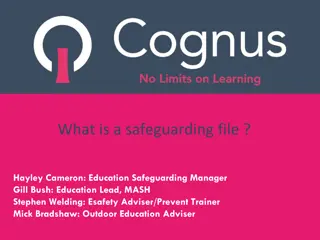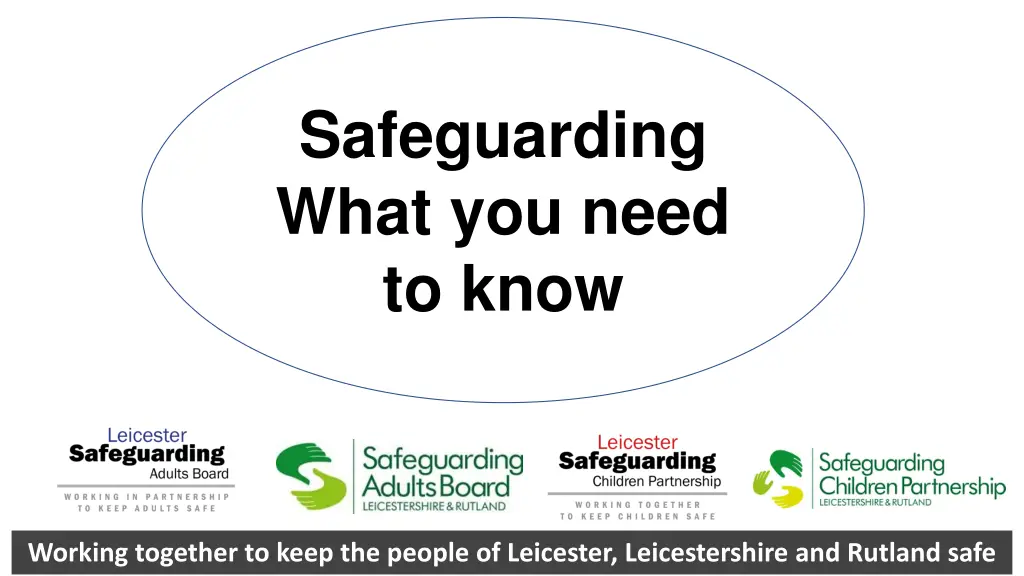
Understanding Safeguarding for Adults: Key Information and Legal Framework
Learn about safeguarding practices for adults in Leicester, Leicestershire, and Rutland, including the legal framework under the Care Act 2014. Discover what constitutes abuse, who is at risk, and the duties involved in safeguarding vulnerable individuals.
Download Presentation

Please find below an Image/Link to download the presentation.
The content on the website is provided AS IS for your information and personal use only. It may not be sold, licensed, or shared on other websites without obtaining consent from the author. If you encounter any issues during the download, it is possible that the publisher has removed the file from their server.
You are allowed to download the files provided on this website for personal or commercial use, subject to the condition that they are used lawfully. All files are the property of their respective owners.
The content on the website is provided AS IS for your information and personal use only. It may not be sold, licensed, or shared on other websites without obtaining consent from the author.
E N D
Presentation Transcript
Safeguarding What you need to know Working together to keep the people of Leicester, Leicestershire and Rutland safe
Safeguarding means protecting an adult s and a child s right to live in safety, free from abuse and neglect.
Adults Adults The Care Act 2014 sets out a clear legal framework for how local authorities and other parts of the system should protect adults at risk of abuse or neglect.
Care Act 2014 Adult at Risk Safeguarding adults became a statutory duty under the Care Act 2014. Safeguarding duties apply to an adult (this is someone 18 and over) who meets all the below: Has needs for care and support (whether or not the local authority is meeting any of those needs) and; and; Is experiencing, or at risk of, abuse or neglect and and; As a result of those care and support needs is unable to protect themselves from either the risk of, or the experience of abuse or neglect.
Who Might Who Might This Include? This Include? People with learning disabilities People with physical disabilities People with sensory disabilities People with mental ill health People who are frail due to their age People with dementia People who misuse drugs or alcohol People with brain injuries
The term abuse is defined as: Adult Adult Safeguarding Safeguarding Definition of Definition of Abuse Abuse A violation of an individual s human and civil rights by any other person; or persons which may result in significant harm Abuse may be: A single act or repeated acts; an act of neglect or a failure to act; multiple acts (for example, an adult may be neglected and financially abused) Taken from Leicester, Leicestershire & Rutland Safeguarding Adults Multi-Agency Policy & Procedures
Continued: Adult Adult Safeguarding Safeguarding Definition of Definition of Abuse Abuse Abuse is about the misuse of the power and control that one person has over another. Where there is dependency, there is a possibility of abuse or neglect unless adequate safeguards are put in place. Intent is not necessarily an issue at the point of deciding whether an act or a failure to act is abuse; it is the impact of the act on the person and the harm or risk of harm to that individual. Acts of abuse may constitute a criminal offence. Taken from Leicester, Leicestershire & Rutland Safeguarding Adults Multi-Agency Policy & Procedures
Safeguarding Children Safeguarding Children The Children Act 1989 is the key piece of legislation that talks about safeguarding children. However there have been other pieces of legislation since, such as Children Act 2004 and The Children and Social Work Act 2017. So that practitioners know what to do, the Department for Education publishes guidance the most recent is: Working Together to Safeguard Children 2023 .
Abuse and neglect are forms of maltreatment of a child. Somebody may abuse or neglect a child by inflicting harm, or by failing to act to prevent harm. Harm can include ill treatment that is not physical as well as the impact of witnessing ill treatment of others. This can be particularly relevant, for example, in relation to the impact on children of all forms of domestic abuse, including where they see, hear, or experience its effects. Children may be abused in a family or in an institutional or extra-familial contexts by those known to them or, more rarely, by others. Abuse can take place wholly online, or technology may be used to facilitate offline abuse. Children may be abused by an adult or adults, or another child or children Working Together to Safeguard Children 2023 Children s Children s Safeguarding Safeguarding Definition of Definition of Abuse and Neglect Abuse and Neglect A child is defined in Working Together to Safeguard Children 2023 as anyone who has not yet reached their 18th birthday .
Is abuse Is abuse always always intentional? intentional? No! It can be the result of negligence or ignorance. Sometimes it can be the result of well-intentioned actions but remember that ABUSE is about the impact of the act on the individual, not the intent.
Childrens Abuse & Definitions Abuse can be viewed in terms of the following categories All definitions have been taken from Working Together to Safeguard Children 2023 Emotional Physical Sexual Neglect
Physical Abuse Children Physical Abuse Children Physical Abuse Physical Abuse Children Children A form of abuse which may involve hitting, shaking, throwing, poisoning, burning, or scalding, drowning, suffocating, or otherwise causing physical harm to a child. Physical harm may also be caused when a parent or carer fabricates the symptoms of, or deliberately induces, illness in a child.
Emotional Abuse Emotional Abuse Children Children The persistent emotional maltreatment of a child so as to cause severe and persistent adverse effects on the child s emotional development. [ ] Some level of emotional abuse is involved in all types of maltreatment of a child, though it may occur alone.
Neglect Neglect Children The persistent failure to meet a child s basic physical and/or psychological needs, likely to result in the serious impairment of the child s health or development. Neglect may occur during pregnancy as a result of maternal substance abuse. Once a child is born, neglect may involve a parent or carer failing to: provide adequate food, clothing or shelter (including exclusion from home or abandonment) protect a child from physical and emotional harm or danger ensure adequate supervision (including the use of inadequate caregivers) ensure access to appropriate medical care or treatment provide suitable education It may also include neglect of, or unresponsiveness to, a child s basic emotional needs. Children
Sexual Abuse Sexual Abuse Children Children Involves forcing or enticing a child or young person to take part in sexual activities, not necessarily involving a high level of violence, whether or not the child is aware of what is happening. The activities may involve physical contact, including assault by penetration (for example, rape or oral sex) or non-penetrative acts, such as masturbation, kissing, rubbing, and touching outside of clothing. They may include non-contact activities, such as: involving children in looking at, or in the production of, sexual images watching sexual activities encouraging children to behave in sexually inappropriate ways grooming a child in preparation for abuse. Sexual abuse can take place online and technology can be used to facilitate offline abuse. Sexual abuse is not solely perpetrated by adult males. Women can also commit acts of sexual abuse, as can other children.
Extra-familial harm Children Children may be at risk of or experiencing physical, sexual, or emotional abuse and exploitation in contexts outside their families. While there is no legal definition for the term extra-familial harm, it is widely used to describe different forms of harm that occur outside the home. Children can be vulnerable to multiple forms of extra-familial harm from both adults and/or other children. Examples of extra-familial harm may include (but are not limited to): criminal exploitation (such as county lines and financial exploitation) serious violence modern slavery and trafficking online harm sexual exploitation child-on-child (non-familial) sexual abuse and other forms of harmful sexual behaviour displayed by children towards their peers abuse, and/or coercive control, children may experience in their own intimate relationships (sometimes called teenage relationship abuse) the influences of extremism which could lead to radicalisation. (Working Together to Safeguard Children 2023)
Some of the signs that might be an indicator that a child is experiencing abuse or neglect: Some of the signs that might be an indicator that a child is experiencing abuse or neglect: Unexplained changes in behaviour or personality Becoming withdrawn/seeming anxious Becoming uncharacteristically aggressive Lack of social skills and few friends, if any Poor bond or relationship with a parent Restrictive movements or access to personal resources Knowledge of adult issues inappropriate for their age Isolation You may also notice some concerning behaviour from adults who have children in their care Always choosing to wear clothes that cover their body Unexplained injuries / inconsistent explanations Running away or going missing
Adult Abuse & Definitions Abuse can be viewed in terms of the following categories: Psychological Self-Neglect Financial or Material Physical Domestic Abuse Discriminatory Organisational Modern Slavery Sexual Neglect and Acts of Omission
Physical Abuse Physical Abuse DEFINITION Physical mistreatment of one person by another which may or may not result in physical injury. TYPES Assault, hitting, slapping, pushing, misuse of medication, poor moving and handling, restraint or inappropriate physical sanctions. SIGNS Unexplained injuries Unexplained bruises Wounds on: face, lips, mouth, arms, torso, back, buttocks, thighs Lacerations/abrasions: mouth, lips, gums, eyes, external genitalia Marks on body: finger marks, hand prints
Domestic Abuse DEFINITION Incident or pattern of incidents of controlling, coercive or threatening behaviour, violence, stalking, or abuse, between those aged 16 or over who are or have been intimate partners or family member regardless of gender or sexuality. TYPES Psychological, physical, sexual, financial, emotional abuse, so called honour based violence, Female Genital Mutilation and forced marriage. SIGNS Withdrawn, bruising, suddenly behaves differently, can be anxious, clingy, depressed, aggressive, problems sleeping, eating disorders, wets, soils clothes, takes risks, misses attending services or appointments, changes in eating habits, obsessive behaviours, nightmares, drugs, alcohol, self-harm, thoughts about suicide, often accompanied at all times by perpetrator.
Psychological Abuse Psychological Abuse DEFINITION Action or neglect by the carer or any person that while not of a physical nature severely impairs the psychological or well- being of the person. TYPES Emotional abuse, threats of harm or abandonment, deprivation of contact, humiliation, blaming, controlling, intimidation, coercion, harassment, verbal abuse, cyber bullying, isolation or unreasonable and unjustified withdrawal of services or supportive networks. SIGNS Change in appetite (weight loss or weight gain) Deference Passivity Resignation Emotional withdrawal / Low self-image Unexplained fear Sleep disturbance
Financial/Material Abuse Financial/Material Abuse DEFINITION Misappropriation or misuse of money/assets. Transactions to which the person could not consent, or which were invalidated by intimidation/deception. TYPES Theft, fraud, internet scamming, coercion in relation to an adult s financial affairs or arrangements, including in connection with wills, property, inheritance or financial transactions, or the misuse or misappropriation of property, possessions or benefits. SIGNS Unexplained financial problems, unexplained bank account activity Recent changes of deeds or title of property Unusual interest by other in the person s financial affairs or assets Misuse of the person s money by others Uncooperative Power of Attorney, unpaid bills Not accessing activities
Neglect DEFINITION Behaviour by carers that results in the persistent or severe failure to meet the physical and/or psychological needs of an individual in their care. TYPES Ignoring medical, emotional or physical care needs, failure to provide access to appropriate health and support or educational services, the withholding of the necessities of life, such as medication, adequate nutrition and heating. SIGNS Physical condition of the person, bed sores, ulcers, unkempt dirty clothes, person unwashed, dirty hair or nails Poor, inappropriate or unsafe environment, hoarding, inadequate diet and malnutrition Failure to give/take medication, untreated medical problems Isolated, won t socialise/ not encouraged to socialise
Self Self- -Neglect Neglect DEFINITION OF SELF-NEGLECT This includes a wide range of behaviour neglecting to care for one s personal hygiene, health or surroundings. TYPES Hoarding Not looking after personal hygiene Failure to tend to own health needs and seek medical care/advice and treatment as and when required SIGNS Physical condition of the person, bed sores, ulcers, unkempt, dirty clothes, person unwashed, dirty hair or nails Poor, inappropriate or unsafe environment, hoarding, inadequate diet and malnutrition Failure to take medication, untreated medical problems Isolated, won t socialise
Discriminatory Discriminatory Abuse Abuse DEFINITION Any form of abuse based on discrimination because of a person s race, culture, belief, age, gender, disability, sexual orientation, etc. Discrimination may be a motivating factor in other forms of abuse. TYPES Forms of harassment, slurs or similar treatment. Personal discrimination: name calling, isolating, harassing, hate crime. Organisational discrimination: withholding services, failing to meet cultural or religion needs. SIGNS Lack of respect shown to an individual Sub-standard service to an individual Exclusion from rights, services or activities that others have Prejudicial attitudes towards others based on their gender, sexual orientation, race, belief, etc. Failure to accommodate dietary needs Not helping people to practice their faith
Sexual Abuse Sexual Abuse DEFINITION The involvement of a person in sexual activities or relationships that either they do not want and have not consented to, or they cannot understand. TYPES Rape, indecent exposure, sexual harassment, inappropriate looking or touching, sexual teasing or innuendo, sexual photography, subjection to pornography or witnessing sexual acts, indecent exposure and sexual assault and sexual assault or sexual acts to which the adult has not consented or was pressured into consenting. SIGNS Changes in behaviour, mood swings, withdrawn/depressed, poor concentration Pregnancy No bowel control Difficulties in walking or sitting Blood-stained or soiled clothing Bruises or injuries on: upper arms or thighs Pain, bleeding Itching in the genital area
Organisational Abuse Organisational Abuse DEFINITION Repeated incidents of poor professional practice or neglect. Inflexible services based on the needs of providers rather than the person receiving services. TYPES Neglect and poor care practice within an institution or specific care setting such as a hospital or care home, for example, or in relation to care provided in one s own home. This may range from one off incidents to ongoing ill treatment. It can be through neglect, poor professional practice as a result of the structure, policies, processes and practices within an organisation. SIGNS Inappropriate or poor care/lack of flexibility in the care regime Sensory deprivation/denial of aids hearing aids, glasses, walking frame, etc. Lack of choice meal times, food, clothes, etc. Lack of personal possessions/lack of privacy or dignity Attitudes and behaviour of staff towards service users
Modern Slavery DEFINITION Traffickers and slave masters use whatever means they have at their disposal to coerce, deceive and force individuals into a life of abuse, servitude and inhumane treatment. TYPES Human trafficking/forced labour, domestic servitude/sexual exploitation SIGNS Is not free to leave or come and go, poor mental health, fearful, anxious, depressed, submissive, tense, nervous/paranoid, fearful or anxious, avoids eye contact. Poor physical health, appears malnourished, shows signs of physical and/or sexual abuse, physical restraint, confinement, or torture, lack of control, has few or no personal possessions, not in control of own money, no financial records, or bank account, is not allowed or able to speak for themselves (a third party may insist on being present and/or translating). Has numerous inconsistencies in their story.
Nail Bars Construction Car Washes Agriculture Care Homes Hotel & Restaurant Modern slavery doesn t happen in all nail bars, car washes etc; however, these are the workplaces where incidents have been reported.
When it comes to safeguarding, we all need to be vigilant, in both our everyday lives as well as our working life. Raising awareness is the first step. Wider Community Safety Wider Community Safety
Concerns about adults working with children Concerns about adults working with children If you have concerns about a member of staff, a volunteer or a member of the public who is in a position of trust working with a child or young person, please contact the LADO (Local Authority Designated Officer)/Allegations Managers to discuss your concerns: Leicestershire CFS-LADO@leics.gov.uk 0116 305 4141 Leicester City Lado-allegations-referrals@leicester.gov.uk 0116 454 2440 Rutland LADO@rutland.gov.uk 01572 758 454
Concerns about adults Concerns about adults working with adults working with adults If you have concerns about a Person in a Position of Trust working with adults at risk, the concerns need to be raised with the relevant agency / organisation.
Even if abuse is not occurring, it may be a situation that someone needs support with. Don t worry that you have misunderstood a situation. Within your role, it is not your job to investigate just report. Report any concerns you may have, as soon as possible.
The priority should always be to ensure the safety and protection of the adult or child at risk. To this end, it is the responsibility of us all to act on any suspicion or evidence of abuse or neglect and to pass the concerns to a responsible person or agency.
Immediate safety and Immediate safety and risk assessment risk assessment The safety and welfare of the individual is your main priority. You should ensure the immediate safety and welfare of the adult or child at risk without putting yourself in any danger. This may include: - Urgent medical attention or contacting the police on 999 In this event, take the necessary action immediately by reporting.
What if someone does What if someone does not want me to report? not want me to report? Explain to the person that you must report the concern if it s safe to do so and won t put them at risk. It is vital to pass concerns on because: Other people may be at risk. There might be other issues that you re unaware of. You should not have to carry the responsibility alone.
Reporting concerns about adults If you think an adult is being abused or neglected, you can report the abuse or neglect to the adult social care service where they live: Leicester City: Telephone: 0116 454 1004 (operational 24 hours a day, 7 days a week) Leicestershire: Telephone: 0116 305 0004 (Monday to Thursday, 8.30am to 5pm, Friday 8.30am to 4.30pm) Emergency Duty Team for Leicestershire: Telephone: 0116 305 0888 (Evenings, weekends, Bank Holidays) Rutland: 01572 758 341 (Monday to Thursday, 8.30am to 5pm, Friday 8.30am to 4.30pm and out of hours)
If you think a child is being abused or neglected, you can report the abuse or neglect of the child to the children s social care service where they live: Reporting concerns about children Leicester City: Telephone: 0116 454 1004 (24-hour service) Leicestershire: Telephone: 0116 305 0005 (24-hour phone line) Rutland: Telephone: 01572 758 407 (Open: Monday to Thursday, 8.30am to 5pm and Friday, 8.30am to 4.30pm. Outside of these hours, call: 0116 305 0005)
For more information, please refer to the Safeguarding procedures Leicester, Leicestershire & Rutland Safeguarding Children Partnerships Procedures manual https://llrscb.trixonline.co.uk/ Leicester, Leicestershire & Rutland Safeguarding Adults Boards Multi-Agency Policies & Procedures https://www.llradultsafeguarding.co.uk/
Record your safeguarding concerns Record your concerns accurately, including any minor concerns, and the details of any action you have taken, information you have shared and decisions you have made relating to those concerns. Make records at the time the events happen, or as soon as possible afterwards. If you work for an organisation, please follow your in-house recording procedures.
http://www.caltrate.co.za/files/images/everybody%2520needs%2520calcium.jpghttp://www.caltrate.co.za/files/images/everybody%2520needs%2520calcium.jpg Safeguarding Safeguarding is Everybody s is Everybody s Responsibility Responsibility

